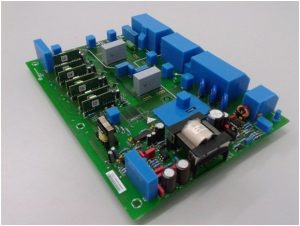Conformal Coating Masking Boots
Posted by Sean Horn
Friday, January 20, 2017 7:29
@ 7:29 AM
Masking is necessary because conformal films like parylene and liquid coatings become insulative after drying, disturbing the performance of such critical components as connector contacts. Custom reusable boots – also called caps or plugs — protect assembly parts in those keep-out areas that must not be coated. In comparison to masking materials like tapes and dots, boots are used for processes demanding an explicit volume of repeat-masking. Reusable boots are designed to quickly cover an entire region-to-be-masked, in a reliably efficient manner. Boots’ return on investment (RoI) is typically achieved much faster, compared to tape and dots.
Different Types of Masking Boot Formats
Boots are typically categorized according to two types: A and C type Cups:

- A Cups are the simplest form, used to cover vertical connectors and components, including masking covers for both d-type and molex connectors.
- C Cups are more complex in design, providing masking for horizontal connectors, wrapping around the component from both sides of the assembly; they can be customized to accommodate complex or irregular surfaces and edges.
- Both A and C Cup boots provide reliable protection of any static-sensitive components they cover.
- These formats can be created in a wide range of custom sizes and shapes to accommodate most relevant masking and production requirements.
Boots are available in different sizes and colors; their precise composition varies according to the
- function, shape and size of the component, and
- application requirements of the coating material.
Silicone rubber and alternative low hardness elastomers are the most common boot materials, due to their resilience when in use and increased sealing properties. ESD-safe masking boots are always available, although their cost is generally higher.
Advantages of Masking Boots: Their Diversity and Versatility
Conformal coating masking boots fasten over such assembly components as connectors, header pins, plugs and sockets. Boots provide dependable security from the incursion of applied conformal coating, prohibiting coating seepage onto the component, which could disrupt its function. Well designed and applied boots can be used with most conformal coating materials. including wet substances like acrylic, epoxy, silicone, and urethane, and CVD parylene.
While the effectiveness of other masking solutions – liquid latex, tapes and dots – is undeniable for many purposes, their application can be costly, labor-intensive and time-consuming, extending production schedules while limiting RoI. In comparison, boots generate a labor-saving alternative for both masking components prior to conformal film application and demasking, once coatings have dried.
Properly applied, masking boots typically save as much as 75% of operating costs, compared to tape and dots, because of the reduction in both masking and demasking time/labor. In addition, boots don’t leak as frequently as tapes or dots can, eliminating the need for masking (and coating) re-work.
Although there is an initial expense of constructing custom-made boots, its cost is quickly recovered by continual reuse; there is no need to constantly purchase new materials, as is the case with tapes and dots. These conditions remain true even for small volumes of repeat processing, saving you time and money in comparison to hand-masking. Appropriately constructed and maintained, masking boots can be reused as many as 200(+) times, and are applicable to both parylene and liquid conformal coating processes.
However, although safely used for parylene CVD and liquid spray applications, boot masking is not recommended for dip applications. The boot resting atop the keep-out area does not form an adequate seal during dipping; conformal coating may seep under the boot, corrupting the contacts or related components. This disadvantage is minimal compared to boots’ cost-effectiveness and rapid production capacities for other coating application methods.
Covering whole areas of an assembly rapidly and effectively, boots are very adaptable, providing component protection during dipping, spraying, CVD and wave-soldering of the printed circuit board. Much of their functional versatility stems from the variety of boot types available for masking purposes.
Selecting Conformal Coating Masking Boots
The precise typology of masking boots is complicated by the ongoing development of PCBs and related electrical assemblies. Their ever-changing configurations and increasing sophistication demand a similar evolution in boots, to accommodate changes in the physical topography of the boards and their sensitive components.
For instance, header pin masking boots come in standardized or custom configurations and sizes, varying in such component categories as:
- the diameter, depth, height, pitch, width of the boot hole,
- the number of holes/strip, and
- whether the component is single- or double-rowed.
Similarly, such items as D Sub boots, Mag A or B boots, rectangular boots, slotted strips, custom edge strips and plugs are available in standardized sizes or can be customized, varying according to such component-specific factors as its size and shape or the number of holes/strip, as well as in differences in external and internal length.
As a simple spray shield for liquid conformal coatings, a boot can be used multiple times. The same is true for molex boots when applied for spray-shielding purposes, but over time these boots may begin to deteriorate after multiple liquid dipping or parylene CVD uses, potentially allowing coating-seepage into the component. Then boots need to be replaced.
Ultimately, boot design and type is a function of:
- the size/shape of the component being masked,
- its location on the PCB assembly,
- the kind of conformal coating covering the assembly, and
- its application methodology.
These factors largely determine its ultimate type, whether standard or customized.
To learn more about masking boots, download our whitepaper: Conformal Masking Boots Whitepaper
Comments
Homepage 4/17/2020. 10:17:10 AM
... [Trackback] [...] Informations on that Topic: blog.paryleneconformalcoating.com/whats-the-difference-between-potting-and-conformal-coating/ [...]

londondrugscanada.bigcartel.comlondon-drugs 4/17/2020. 10:17:10 AM
cialis uk https://londondrugscanada.bigcartel.com/london-drugs This is nicely expressed. !